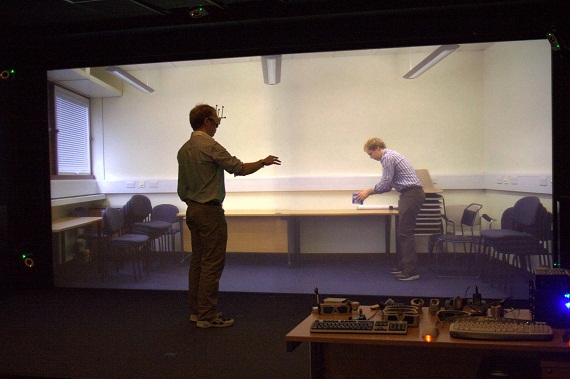Perception of action in real life
We have shown that watching actions leads to biases in the subsequent perception of other acting individuals (action adaptation). Our perception of another agent at any one point in time is not just a representation of their behaviour, but also a product of our immediate perceptual history. Judgments we make about other individuals are therefore subject to short term biases in visual processing.
In ESRC funded research (Grant RES-062-23-23-2797) in collaboration with James Ward at the Hull Immersive Visualisation Environment (HIVE) we are performing experiments to test how action adaptation biases our judgements of other individuals, whilst using visual adaptation techniques to determine how brain mechanisms are operating under simulated “Real Life” conditions. During experiments, participants view full-scale, 3-dimensional (3D), true high-definition (HD), high frame rate (50Hz) movies of actors via the HIVE 5.3m x 2.4m projection system. This system allows us to perform highly controlled psychological testing of participants whilst they experience an immersive simulated real-life environment. This form of experimentation allows us to access perceptual mechanisms operating naturally that cannot be achieved using traditional psychophysical or any neuroimaging techniques.

Here Bruce Keefe is viewing a test movie presented at 100Hz on the HIVE wall through LCD glasses. These LCD glasses ensure that each eye receives alternate and different images - the movie shown to each eye is therefore at 50Hz. This technique allows vivid stereoscopic presentation of photo-realistic movies such that the viewer appears to be within the scene with the actor.
Experiments are controlled by MATLAB and we have developed a 3D player (mex3Dplayer) that allows MATLAB running the psychophysics toolbox to call and display stereo .mp4 files containing experimental footage
Funding provided by